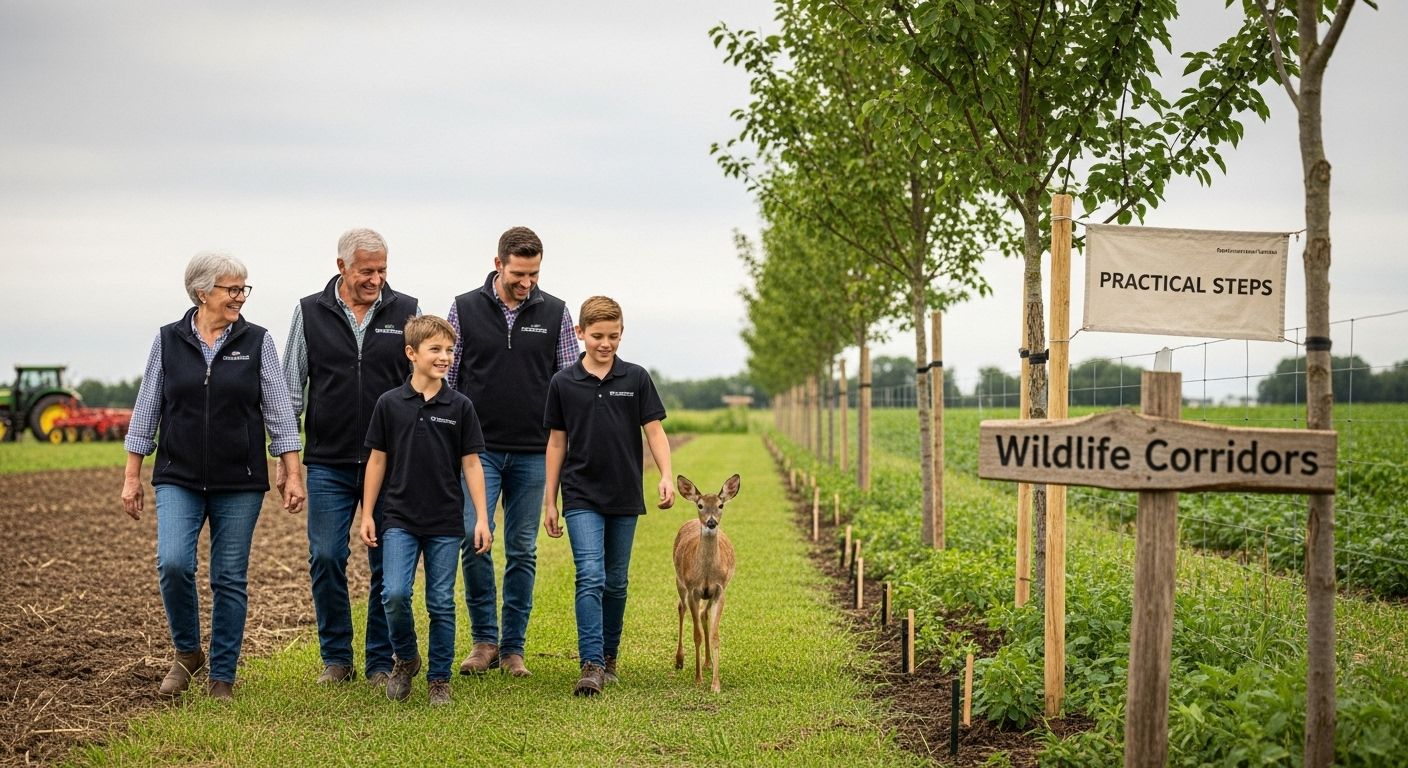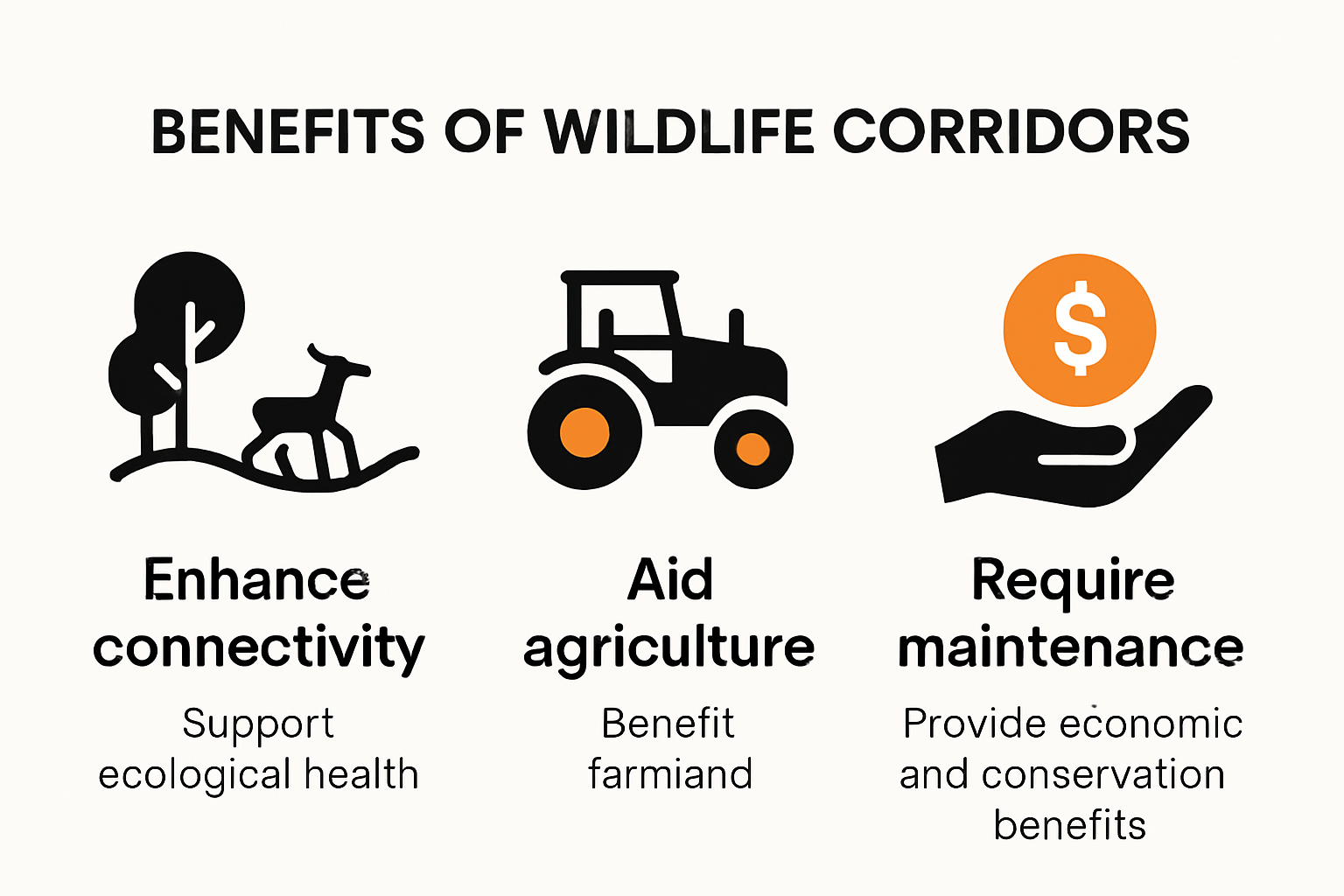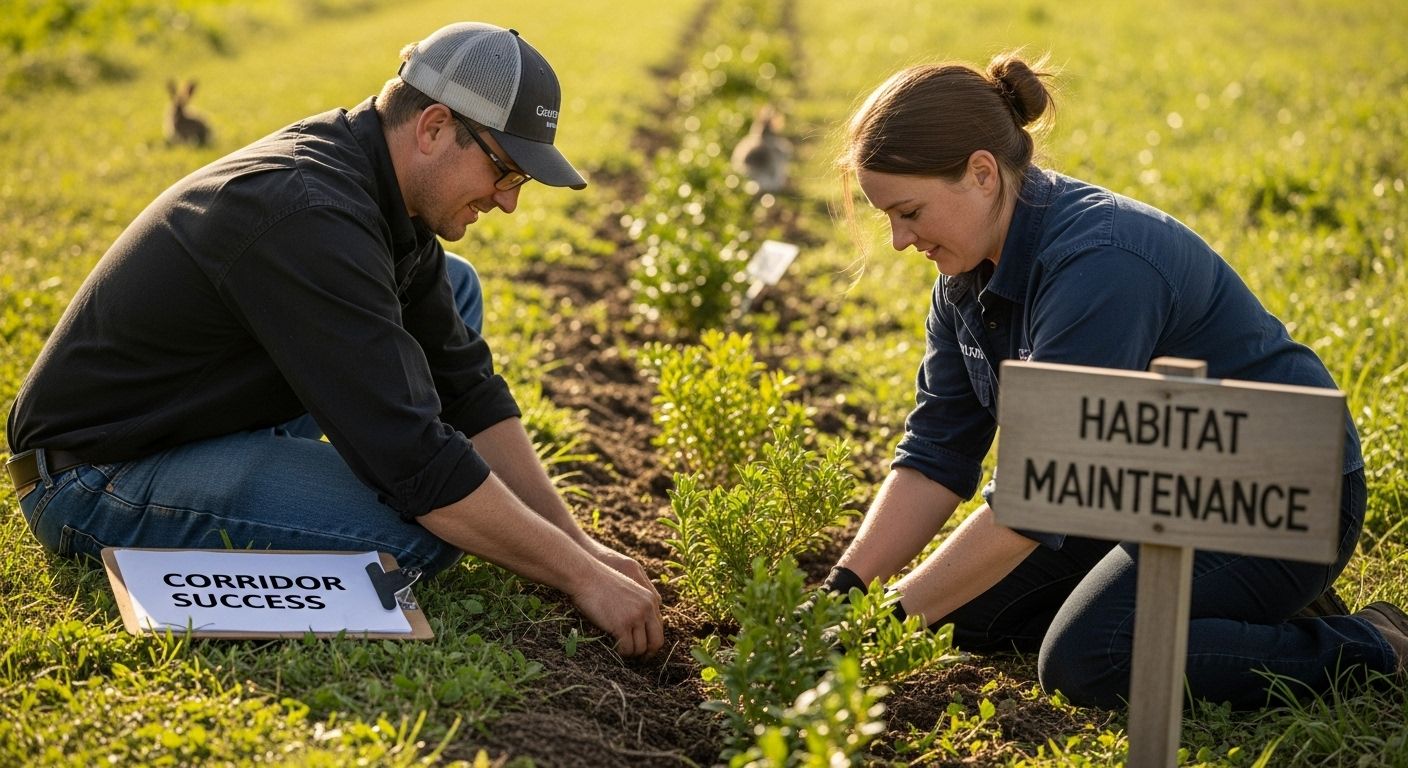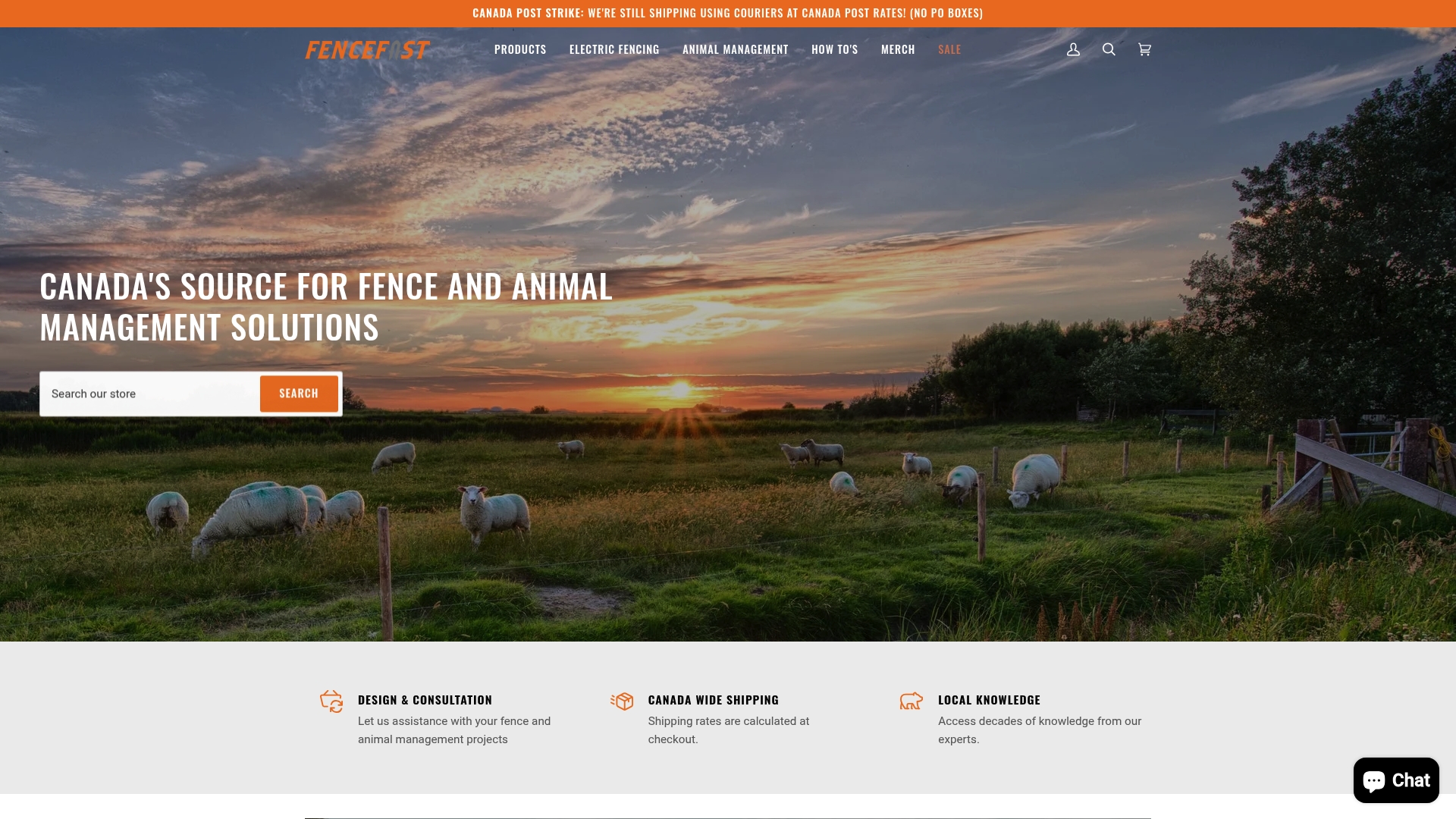
Wildlife corridors might sound like a big undertaking for the average landowner or farmer, especially if you worry about sacrificing productive acreage. Yet studies reveal that over 70 percent of successful wildlife corridors in North America run right through working farms or ranches. Most people assume you need untouched wilderness to make a real impact. In fact, the biggest difference often starts on ordinary fields and fence lines—proving that even small changes on your land can help entire species survive.
Table of Contents
- Understanding Wildlife Corridors And Their Benefits
- Planning And Designing Effective Wildlife Pathways
- Tools, Equipment, And Maintenance For Corridor Success
- Real-World Tips For Farmers And Rural Teams
Quick Summary
| Takeaway | Explanation |
|---|---|
| Wildlife corridors enhance ecological health | These pathways allow safe animal movement, supporting species survival and genetic diversity. |
| Agricultural lands can support wildlife | Strategic management of farming areas can create wildlife-friendly corridors without sacrificing productivity. |
| Effective planning is essential for success | Understanding local ecosystems and wildlife patterns is crucial for designing effective wildlife pathways. |
| Ongoing maintenance ensures corridor effectiveness | Regularly monitoring vegetation and addressing invasive species is vital for sustaining wildlife habitats. |
| Economic benefits accompany conservation efforts | Wildlife corridors can improve pest control, boost pollination, and qualify for conservation funding. |

Understanding Wildlife Corridors and Their Benefits
Wildlife corridors represent strategic pathways that enable animals to move safely between different habitat areas, serving as critical lifelines for ecosystem health and species survival. These natural or human-designed routes provide essential connections that allow wildlife to access critical resources, migrate seasonally, and maintain genetic diversity across fragmented landscapes.
The Ecological Significance of Wildlife Movement
Ecosystems depend on animal movement for long-term survival and adaptation. The U.S. Fish & Wildlife Service emphasizes that wildlife corridors are fundamental in maintaining healthy species populations by enabling animals to traverse landscapes and access necessary areas for feeding, breeding, and shelter. Without these critical pathways, animal populations become isolated, which can lead to genetic stagnation and increased vulnerability to environmental changes.
Genetic diversity plays a crucial role in species resilience. The University of New Hampshire Extension highlights that wildlife corridors help protect species by facilitating gene flow between populations. This movement allows animals to interbreed, reducing the risks of inbreeding and supporting genetic adaptability. When wildlife can move freely, they can respond more effectively to environmental shifts, climate changes, and habitat disruptions.
Agricultural Lands and Wildlife Connectivity
Contrary to popular belief, agricultural landscapes can play a significant role in creating effective wildlife corridors. The USDA’s Natural Resources Conservation Service notes that working lands can be strategically managed to support both agricultural productivity and wildlife habitat connectivity. Landowners can transform portions of their property into wildlife-friendly spaces that facilitate animal movement while maintaining agricultural operations.
Effective wildlife corridors on agricultural lands typically involve:
- Native Vegetation Strips: Maintaining continuous strips of native plants that provide cover and movement routes
- Riparian Buffers: Preserving and enhancing vegetation along waterways
- Minimized Fragmentation: Designing agricultural practices that reduce landscape interruptions
To help readers compare practical ways farmland can support wildlife corridors, the following table summarizes key corridor types and their functions as described in the article.
| Type of Wildlife Corridor | Description | Main Function |
|---|---|---|
| Native Vegetation Strips | Continuous strips of native plants | Provide cover and movement routes |
| Riparian Buffers | Vegetation along waterways | Enhance waterway habitats, connectivity |
| Minimized Fragmentation Areas | Managed to reduce interruptions in landscape | Maintain unbroken travel for wildlife |
| Hedgerows | Man-made linear plantings, e.g., along fencelines | Serve as both habitat & safe passage |
| Forested Ridges/Natural Routes | Existing landscape features leveraged for travel | Link isolated habitats naturally |
By understanding and implementing wildlife corridors, landowners become critical partners in conservation efforts. These pathways are not just ecological necessities but represent a holistic approach to land management that recognizes the interconnectedness of human activities and natural systems. Creating wildlife corridors requires thoughtful planning, an understanding of local ecosystems, and a commitment to supporting biodiversity beyond traditional conservation boundaries.
Planning and Designing Effective Wildlife Pathways
Creating effective wildlife pathways requires strategic planning, thoughtful design, and a comprehensive understanding of local ecosystem dynamics. These pathways are not simply random strips of land but carefully engineered connections that support animal movement, genetic diversity, and habitat connectivity.
Strategic Corridor Layout and Connectivity
Penn State Extension highlights the critical importance of understanding how wildlife corridors connect isolated habitats. These pathways can be natural features like forested ridges or human-designed structures such as hedgerows. The key is creating routes that provide both safe passage and essential resources for different species.
Successful wildlife pathway design involves multiple considerations. Landowners must analyze existing landscape features, understand local wildlife movement patterns, and identify potential barriers that might interrupt animal travel. This requires mapping current habitat zones, tracking animal migration routes, and recognizing natural topographical advantages that can be enhanced to support wildlife movement.
Transportation Infrastructure and Wildlife Safety
The University of Florida’s Institute of Food and Agricultural Sciences offers crucial insights into designing wildlife-friendly transportation systems. Their research demonstrates that carefully constructed crossings can significantly reduce habitat fragmentation and animal mortality. Key recommendations include:
- Culvert Design: Constructing underpasses with dry areas and natural substrates
- Speed Management: Implementing speed bumps near wildlife crossing zones
- Vegetation Screening: Using strategic plantings to guide and protect animal movements
Habitat Planting and Corridor Enhancement
The Wisconsin Department of Natural Resources provides comprehensive guidance on selecting and arranging vegetation to support wildlife corridors. Their recommendations focus on creating diverse, interconnected plant communities that offer multiple benefits to local fauna.
Effective habitat planting involves:
- Diverse Plant Selection: Mixing conifers, hardwoods, and shrubs
- Strategic Placement: Considering existing travel lanes and food sources
- Continuous Coverage: Ensuring minimal gaps in vegetation to provide consistent protection
By approaching wildlife pathway design as a holistic ecosystem management strategy, landowners can create valuable ecological infrastructure. These corridors are not just beneficial for wildlife but represent a proactive approach to conservation that recognizes the intricate connections between human land use and natural habitats.
Tools, Equipment, and Maintenance for Corridor Success
Successful wildlife corridor implementation requires more than initial planning. Landowners must invest in appropriate tools, equipment, and ongoing maintenance strategies to ensure these ecological pathways remain functional and effective for wildlife movement and habitat connectivity.
Essential Equipment for Corridor Development
Creating and maintaining wildlife corridors demands specialized equipment that supports habitat restoration and management. Landowners should consider investing in tools that enable precise vegetation management, soil preparation, and ecosystem restoration. Key equipment includes:
- Vegetation Management Tools: Selective mowers, brush cutters, and precision pruning equipment
- Soil Preparation Devices: No-till seeders, native plant drills, and ground preparation machinery
- Monitoring Equipment: Trail cameras, GPS mapping devices, and wildlife tracking sensors
To clarify the main equipment and maintenance strategies for developing and sustaining wildlife corridors, the following table organizes the tools, technologies, and approaches outlined in the article section.
| Category | Examples | Purpose |
|---|---|---|
| Vegetation Management | Selective mowers, brush cutters | Manage plant growth, maintain clear corridors |
| Soil Preparation | No-till seeders, plant drills | Prepare ground and promote native vegetation |
| Monitoring Tools | Trail cameras, GPS mapping devices | Observe animal movement and assess corridor health |
| Technology | GIS software, drones, tracking systems | Map, monitor, and optimize corridors |
| Maintenance Strategy | Invasive species control, replanting | Sustain habitat quality and ecological balance |
Vegetation and Habitat Maintenance Strategies
Regular maintenance is critical for sustaining wildlife corridor effectiveness. MassWildlife emphasizes the importance of ongoing habitat management through technical and financial assistance programs. Successful maintenance involves several strategic approaches:
- Invasive Species Control: Regular monitoring and removal of non-native plant species that could disrupt native ecosystem balance
- Native Plant Restoration: Periodic replanting of indigenous vegetation to maintain corridor quality
- Soil Health Management: Implementing erosion control and soil conservation techniques
Technology and Monitoring Tools
Advanced technological tools have transformed wildlife corridor management, enabling more precise and effective conservation efforts. Modern landowners can leverage:
- GIS Mapping Software: Detailed landscape mapping and corridor tracking
- Drone Technology: Aerial surveys for comprehensive habitat assessment
- Wildlife Tracking Systems: Advanced sensors and camera networks to monitor animal movement
Successful wildlife corridor maintenance requires a holistic approach that combines technological innovation, strategic equipment usage, and consistent ecosystem management. By investing in appropriate tools and developing comprehensive maintenance strategies, landowners can create resilient, functional wildlife pathways that support local biodiversity and ecological connectivity.

Continuous learning, adaptability, and a commitment to ecosystem health are essential. Each wildlife corridor is unique, demanding tailored approaches that consider local environmental conditions, wildlife species, and landscape characteristics. Landowners who approach corridor development as an ongoing, dynamic process will achieve the most significant conservation outcomes.
Real-World Tips for Farmers and Rural Teams
Implementing wildlife corridors on agricultural and rural lands requires practical strategies that balance conservation goals with productive land management. Farmers and rural teams play a crucial role in creating sustainable ecosystems that support both agricultural productivity and wildlife conservation.
Integrating Corridors with Agricultural Practices
Successful wildlife corridor implementation begins with understanding how conservation can complement existing agricultural operations. The National Sustainable Agriculture Coalition highlights that agricultural lands can serve as critical habitats while maintaining productive farming practices.
Key integration strategies include:
- Marginal Land Utilization: Transforming unproductive field edges and unused areas into wildlife corridors
- Crop Rotation Considerations: Designing field layouts that support wildlife movement
- Buffer Zone Management: Creating strategic vegetative buffers between cultivated areas and natural habitats
Practical Implementation Techniques
The USDA Natural Resources Conservation Service provides guidance on developing practical wildlife corridor approaches that work with existing land management systems. Effective implementation requires:
- Comprehensive Site Assessment: Thoroughly evaluating landscape features and wildlife movement patterns
- Species-Specific Planning: Understanding local wildlife needs and behavior
- Gradual Corridor Development: Implementing corridors in phases to minimize disruption to agricultural operations
Economic and Conservation Benefits
Contrary to common misconceptions, wildlife corridors can provide tangible economic benefits for rural landowners. These ecological pathways offer multiple advantages:
- Improved Pest Control: Natural predator movement can help manage agricultural pest populations
- Pollination Support: Creating habitats that attract beneficial insects and pollinators
- Potential Conservation Funding: Access to government programs and grants for habitat restoration
Successful wildlife corridor development is not about creating perfect systems but about making strategic, incremental improvements. Rural teams and farmers are uniquely positioned to become conservation leaders by viewing their land as part of a broader ecological network.
The most effective approaches combine scientific understanding with practical, on-the-ground knowledge. By treating wildlife corridors as dynamic, evolving systems, landowners can create resilient landscapes that support both agricultural productivity and ecological health. This approach requires patience, ongoing observation, and a willingness to adapt management strategies based on real-world results.
Ultimately, wildlife corridors represent an investment in long-term land health. They demonstrate a forward-thinking approach to land management that recognizes the interconnected nature of agricultural ecosystems and wildlife habitats.
Frequently Asked Questions
What are wildlife corridors and why are they important?
Wildlife corridors are strategic pathways that allow animals to safely move between different habitat areas. They are essential for maintaining ecosystem health, supporting species survival, and promoting genetic diversity by enabling animal movement across fragmented landscapes.
How can agricultural lands support wildlife corridors without sacrificing productivity?
Agricultural lands can effectively accommodate wildlife corridors by managing unproductive areas, creating native vegetation strips, and implementing riparian buffers. These strategies help facilitate wildlife movement while maintaining agricultural operations and productivity.
What should I consider when planning a wildlife corridor on my property?
When planning a wildlife corridor, consider the existing landscape features, local wildlife movement patterns, potential barriers, and the specific needs of species in your area. Conduct a comprehensive site assessment to ensure the corridor supports both animal passage and essential resources.
What tools and maintenance strategies are essential for sustaining a wildlife corridor?
Essential tools for maintaining a wildlife corridor include vegetation management equipment, soil preparation devices, and monitoring technology such as trail cameras. Regular maintenance strategies should involve invasive species control, native plant restoration, and ongoing habitat management to keep the corridors functional for wildlife.
Turn Wildlife Corridor Plans into Reality with Trusted Fencing Solutions
Protecting natural wildlife movement and supporting genetic diversity on your land can seem demanding, especially when faced with fragmented habitats and concerns about interrupting day-to-day farming. As this article explains, reliable corridor boundaries, safe passageways, and ongoing monitoring are essential for both animal movement and long-term ecosystem health. But manually maintaining these connections and balancing them with productive agriculture often leaves landowners feeling stuck, especially when equipment or specialized support is hard to source.

If you are ready to turn your conservation goals and wildlife corridor projects into lasting results, let FenceFast.ca make your next step easier. Choose from a wide range of fencing and animal management supplies designed for Canadian rural properties, including electric fencing systems, wire, hardware, and animal monitoring tools. Browse our intuitive product catalog and discover how our online ordering and design consulting services can help you build secure, effective corridors without sacrificing productivity. Visit FenceFast.ca today and get expert advice, quality products, and fast shipping to support a healthier landscape and thriving wildlife—all with the solutions you need, now.
Recommended
-
[
PFN16100-1 – FenceFast Ltd.
-
[
Gallagher Turbo Wire 2.5mm – FenceFast Ltd.
-
[
Gripple Small Cable Cutter – FenceFast Ltd.
-
[
Polyrope/Braid to Energizer Connector – FenceFast Ltd.
](https://fencefast.ca/products/polyrope-braid-to-energizer-connector)
